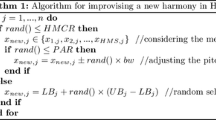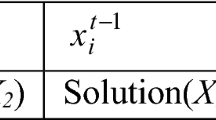Abstract
Clustering is a widely used technique for segmentation of images. In this paper, a method is proposed for image segmentation, which used an Optimized Selective Scale Based Fuzzy c-Means approach. This approach is used to improve the quality of image segmentation. An algorithm named Fuzzy c-means (FCM) is used for data clustering in which an element can belong to multiple clusters. This algorithm results in the transformation of data elements in such a way that closer elements will come more closer and remaining elements will scatter farther. Genetic Algorithm is used as an optimization technique in this model. Genetic Algorithm is one of the commonly used methods to decide the optimal value of a criterion. The optimal value is determined by simulating the evolution of population until the best fitted individuals among the population is not encountered. It is obtained by mutation selection and crossover of individuals from the existing population.
Access provided by Autonomous University of Puebla. Download conference paper PDF
Similar content being viewed by others
Keywords
1 Introduction
The process of Image Segmentation is defined as partitioning or dividing the image into multiple parts (also known as segments) in such a way that pixels in one segment are similar to each other with respect to some characteristic and dissimilar from the ones in other segments. Image segmentation has several applications like Machine vision, Medical imaging, Object detection and many more.
There are several algorithms and techniques available for image segmentation [1, 2]. The simplest and oldest method of image segmentation is Thresholding method. Other famous approaches are based on Detection of Edges, Histogram-based methods, Compression-based methods, Clustering methods and Region-growing methods.
Clustering is a widely used technique for segmentation of images [3]. Clustering further is classified into different categories. An algorithm named Fuzzy c-means (FCM) is used for data clustering in which an element can belong to multiple clusters [4]. Every element in the population has a set of membership values. These membership values determine the intensity of association among the element and the depicted cluster. These membership values are stored in a partition matrix.
For data refinement, a technique named Scale Space Filter is used in which the data elements are transformed to higher dimensions [5]. The objective of using this techniques is to separate the data elements on the basis of proximity and other separability measures. The technique results in the transformation of data elements in such a way that closer elements will come more closer and remaining elements will scatter farther.
In the following approach, a method is designed for image segmentation in which Optimized Selective Scale Based Fuzzy c-Means approach is used. This approach is design to improve the quality of segmentation of images.
2 Methodology
2.1 Selective Scale Spaced FCM Method Based on Standard Deviation
Roy [6], given an algorithm in which they proved that for scale space transformation all parameters are not suitable. So in that algorithm, firstly the standard deviation of each parameter is computed and the value is compared with a threshold value. Only for lower standard deviation value scale space transformation is applied but for the standard deviation value greater than the threshold value scale space filter technique will not be applied on those parameters [23].
Multiple functions are present which can be used for scale space filters. Among them, Polynomial and Gaussian functions are most popular ones. In this methodology, Gaussian transformation function is applied. This function is defined as follows:
Suppose n are the number of objects which are needed to be clustered and the feature vector is represented as S = {p1, p2,….., pn}. Let m are the number of attributes that each point has and C are the number of cluster, C = {k1, k2,…., kc}. Cluster Validity is measured by using Xie-Beni index [7]. We can define this index by using Eq. 2.
The value of member function is given by Eq. 3.
The Center is updated using Eq. 4.
The generic fuzzy c-means algorithm can be described as follows:
-
1:
Declare the Matrix as Fn×CS.
-
2:
Declare ObjValue as Real
-
3:
Initialize the Cluster Center, C
-
4:
while ObjValue \( \le \) Benchmark do
-
5:
Populate Fuzzy Partition Matrix using (3)
-
6:
Update Cluster Center using (4)
-
7:
Update the ObjValue using ObjectiveFunction(C, Fn×C)
-
8:
end while
The fuzzy membership has to be:
where \( 0 \le \mu_{ik} \le 1, i = 1,2, \ldots \ldots , C\, and\,j = 1,2, \ldots \ldots ,n. \)
The Selective Scale Spaced FCM algorithm based on Standard deviation can be described as follows:

2.2 Proposed Method
In proposed method, an optimized approach of selective scale based fuzzy c-means algorithm is presented. There are several optimization techniques. In this model, Genetic Algorithm is applied.
Genetic Algorithm is one of the commonly method used to decide the optimal value of a criterion [8]. The optimal value is determined by simulating the evolution of population until we will not encounter the best fitted individuals among the population. It is obtained by mutation selection and crossover of individuals from the existing population.
Genetic Algorithm consists of following essential data:
-
(a)
Genotype: It is resulted segmented image which is considered as an individual.
-
(b)
Initial Population: It is a set of individuals characterized on the basis of genotype.
-
(c)
Fitness Function: A function which is used to quantify the fitness of individual.
-
(d)
Operators on genotype: There are three different operators. These are mutation, selection and cross-over.
-
(e)
Stopping Criterion: It allows to stop this evolution process.
The proposed algorithm is given as follows:

3 Results
The designed algorithm is applied on the MRI brain images. The results of designed algorithm are compared with existing approach using AE (Average Error), NED (Normalized Euclidean Distance) and SNR (Signal to Noise Ratio) [9]. I(i, j) is considered here as input image where i = 1, 2, 3, 4 …, M and j = 1, 2, 3, 4 …, N and O(i, j) is considered as output image, then the criterion is calculated as follows:
-
(i)
Average Error (AE):
$$ AE = \frac{1}{M \cdot N} \mathop \sum \limits_{i = 1}^{M} \mathop \sum \limits_{j = 1}^{N} \sqrt {(I\left( {i,j} \right) - O\left( {i,j} \right))^{2} } $$(5) -
(ii)
Normalized Euclidean Distance (NED):
$$ NED = \frac{1}{M \cdot N} \sqrt {\mathop \sum \limits_{i = 1}^{M} \mathop \sum \limits_{j = 1}^{N} (I\left( {i,j} \right) - O\left( {i,j} \right))^{2} } $$(6) -
(iii)
Signal to Noise Ratio (SNR):
$$ SNR = 10\log_{10} \left[ {\frac{{\sum\nolimits_{i = 1}^{M} {\sum\nolimits_{j = 1}^{N} {I^{2} (i,j)} } }}{{\sum\nolimits_{i = 1}^{M} {\sum\nolimits_{j = 1}^{N} {(I\left( {i \cdot j} \right) - O\left( {i,j} \right))^{2} } } }}} \right] $$(7)
The comparison between proposed and existing algorithm is shown in Table 1.
The values shown in Table 1 are also plotted in graphs to compare the values of AE, NED and SNR for both the techniques. In graph, the Optimized Scale Spaced FCM is represented with black line and the Selective Scale Spaced FCM is represented with blue line. The graph for comparison according to AE, NED and SNR values are shown in Figs. 1, 2 and 3 respectively.
The MR images after segmentation using proposed method are shown in Fig. 4.
4 Conclusion
In this paper, an algorithm named Fuzzy c-Means is surveyed along with its variation i.e. selective scale space FCM based on standard deviation. An Optimized scale spaced FCM method is proposed in this paper. This proposed algorithm achieves better segmentation results as compared to the existing method.
There is scope of betterment of this algorithm. Firstly, the computational time of this method is higher than the original Fuzzy C-Means algorithm. So, one can try to reduce this computational time in future work. Secondly, in this method Genetic Algorithm is used for optimization purpose. Other optimization techniques can also be used and the results can be compared.
References
Haraliek, R.M., Shapiro, L.G.: Image segmentation techniques. CVGIP 29, 100–132 (1985)
Pal, N.R., Pal, S.K.: A review on image segmentation techniques. Pattern Recogn. 26, 1277–1294 (1993)
Wu, Z., Leahy, R.: An optimal graph theoretic approach to data clustering: theory and it’s applications to image segmentation. IEEE Trans. Pattern Anal. Mach. Intell. 15(11), 1101–1113 (1993)
Iain, A.K., Murty, M.N., Flynn, P.J.: Data clustering: a review. ACM Comput. Surv. 31(3), 264–323 (1999)
Leung, Y., Zhang, J.S., Xu, Z.B.: Clustering by scale-space filtering. IEEE Trans. Pattern Anal. Mach. Intell. 22(12), 1396–1410 (2000)
Roy, P., Mandal, J.K.: A novel selective scale space based fuzzy C-means model for spatial clustering. Procedia Tecnol. 10, 596–603 (2013)
Xie, X.L., Beni, G.: A validity measure for fuzzy clustering. IEEE Trans. Pattern Anal. Mach. Intell. 13(8), 841–847 (1991)
Chabrier, S., Rosenberger, C., Emile, B., Laurent, H.: Optimization based image segmentation by genetic algorithms (2008)
Upadhyay, P., Chhabra, J.K.: Modified self organizing feature map neural network (MSOFM NN) based gray image segmentation. Procedia Comput. Sci. 54, 671–675 (2015)
Ahmed, M.N., Yamany, S.M., Mohamed, N., Farag, A.A., Moriarty, T.: A modified fuzzy C-means algorithm for bias field estimation and segmentation of MRI data. IEEE Trans. Med. Imaging 21(3), 193–199 (2002)
Gulhane, A., Paikrao, P.L., Chaudhari, D.S.: A review of image data clustering techniques. Int. J. Soft Comput. Eng. 2(1), 212–215 (2012)
Hall, L.O., Ozyurt, I.B., Bezdek, J.C.: Clustering with a genetically optimized approach. IEEE Trans. Evol. Comput. 3(2), 103–112 (1999)
Hasanzadeh, M., Kasaei, S.: Multispectral brain MRI segmentation using genetic fuzzy systems, pp. 2–5 (2007)
Sharma, M., Mukherjee, S.: Fuzzy C-means, ANFIS and genetic algorithm for segmenting astrocytoma – a type of brain tumor 3(1) (2014)
Zhu, L., Chung, F.L., Wang, S.: Generalized fuzzy c-means clustering algorithm with improved fuzzy partitions. IEEE Trans. Syst. Man Cybern. Part B (Cybern.) 39, 578–591 (2009)
Shasidhar, M., Raja, V.S., Kumar, B.V.: MRI brain image segmentation using modified fuzzy C-means clustering algorithm, pp. 473–478 (2011)
Bezdek, J.C., Hathaway, R.J.: Optimization of fuzzy clustering criteria using genetic algorithms, pp. 589–594 (1993)
Pal, N.R., Bezdek, J.C.: On cluster validity for fuzzy c-means model. IEEE Trans. Fuzzy Syst 3(3), 370–379 (1995)
Clark, M.C., Hall, L., Goldgof, D.B., Clarke, L.P., Velthuizen, R.P., Silbiger, M.S.: MRI segmentation using fuzzy clustering techniques. IEEE Eng. Med. Biol. 13, 730–742 (1994)
Kaus, M.R., Warfield, S.K.: Automated segmentation of MR images of brain tumors, pp. 586–591 (2001)
Maulik, U., Bandyopadhyay, S.: Fuzzy partitioning using a real-coded variable-length genetic algorithm for pixel classification. IEEE Trans. Geosci. Remote Sens. 41(5), 1075–1081 (2003)
Chen, D., Li, X., Cui, D.-W.: An adaptive cluster validity index for the fuzzy c-means. Int. J. Comput. Sci. Netw. Secur. 7(2), 146–156 (2007)
Monica, Singh, S.K., Agrawal, P., Madaan, V.: Breast cancer diagnosis using digital image segmentation techniques. Indian J. Sci. Technol. 9(28), 1–5 (2016)
Author information
Authors and Affiliations
Corresponding author
Editor information
Editors and Affiliations
Rights and permissions
Copyright information
© 2019 Springer Nature Singapore Pte Ltd.
About this paper
Cite this paper
Sharma, G., Sethi, N., Rana, P. (2019). An Optimized Selective Scale Space Based Fuzzy C-Means Model for Image Segmentation. In: Luhach, A., Jat, D., Hawari, K., Gao, XZ., Lingras, P. (eds) Advanced Informatics for Computing Research. ICAICR 2019. Communications in Computer and Information Science, vol 1075. Springer, Singapore. https://doi.org/10.1007/978-981-15-0108-1_37
Download citation
DOI: https://doi.org/10.1007/978-981-15-0108-1_37
Published:
Publisher Name: Springer, Singapore
Print ISBN: 978-981-15-0107-4
Online ISBN: 978-981-15-0108-1
eBook Packages: Computer ScienceComputer Science (R0)








